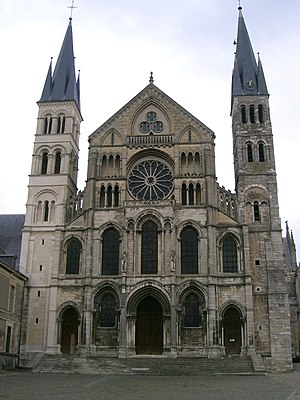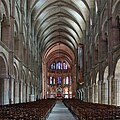Musée Saint-Remi: Difference between revisions
Raggatt2000 (talk | contribs) →History: Added some details on rebuilding of choir. |
Raggatt2000 (talk | contribs) added general ref. |
||
| Line 42: | Line 42: | ||
==Notes== |
==Notes== |
||
{{reflist}} |
{{reflist}} |
||
== References == |
|||
*Wilson, C (2008). ''The Gothic Cathedral'', Thames & Hudson. |
|||
{{commonscat|Basilique Saint-Remi|Saint-Remi Basilica}} |
{{commonscat|Basilique Saint-Remi|Saint-Remi Basilica}} |
||
Revision as of 14:52, 7 February 2010
| UNESCO World Heritage Site | |
|---|---|
 | |
| Criteria | Cultural: i, ii, vi |
| Reference | 601 |
| Inscription | 1991 (15th Session) |
| Coordinates | 49°14′35″N 4°2′31″E / 49.24306°N 4.04194°E |
The Abbey of Saint-Remi is an abbey in Reims, France, founded in the sixth century. Since 1099[1] it has conserved the relics of Saint Remi (died 553), the Bishop of Reims who converted Clovis, King of the Franks, to Christianity at Christmas in AD 496, after he defeated the Alamanni in the Battle of Tolbiac.
The present basilica was the abbey church; it was consecrated by Pope Leo IX in 1049. The eleventh-century nave and transepts, in the Romanesque style, are the oldest; the façade of the south transept is the most recent.
History
The obscure[2] origins of the great abbey at Reims lie in a little chapel of the sixth century dedicated to Saint Christopher, its success was founded on its acquisition of the relics of St. Remy in 553: subsequently gifts poured in upon it from pious donors. By the ninth century the abbey possessed about seven hundred domains and was perhaps the most richly endowed in France. It seems probable that secular priests were the first guardians of the relics, but were succeeded by the Benedictines. From 780 to 945 the archbishops of Reims served as its abbots. At the abbey Charlemagne received Pope Leo III.
In 1005 the abbot Aviard undertook to rebuild the church of St-Remy, and for twenty years the work went on uninterruptedly before vaulting collapsed, no doubt from insufficient buttressing. Abbot Theodoric erected the magnificent surviving basilica which Pope Leo IX dedicated in 1049 and to which he granted many privileges. The abbey library and its schools were of such high repute that Pope Alexander III wrote a commendatory letter to the Abbot Peter, which survives.
The years of around 1170 to 1180 brought further rebuilding, this time to the choir. The purpose of replacing the short eastern section of the Romanesque church was to create a grander and more spacious interior for the shrine of St Remy. The shrine was detached from its previous location, next to the altar, and moved further east.[3]
The archbishops of Reims and several princes, Carloman, brother of Charlemagne, Henri d'Orléans (d. about 1653), and kings Louis IV of France and Lothair were buried in the monastery.
Among the illustrious later abbots, all drawn from the higher nobility, may be mentioned: Henri de Lorraine (1622-1641), who affiliated the abbey to the Congregation of St. Maur; Jacques-Nicolas Colbert (1665), later archbishop of Rouen; Charles Maurice Le Tellier (1680-1710); and Joseph de Rochechouart, appointed abbot by the king in 1745.
Many valuable objects from the abbey were looted in the French Revolutionary period, but the 12th-century stained glass remains.
The Abbey of Saint-Remi, together with the nearby cathedral of Notre-Dame de Reims and Palace of Tau, became a UNESCO World Heritage Site in 1991.
Gallery
-
Nave
-
South façade
-
Choir
-
Choir from South East
Notes
- ^ St Remi's relics were kept in the Cathedral of Reims, whence Hincmar had them translated to Epernay during the Viking invasions and thence, in 1099 to the Abbey of Saint-Rémy.
- ^ Catholic Encyclopedia, 1911, s.v. "Abbey of Saint Remy"
- ^ Wilson 2008, p.60, 62
References
- Wilson, C (2008). The Gothic Cathedral, Thames & Hudson.




